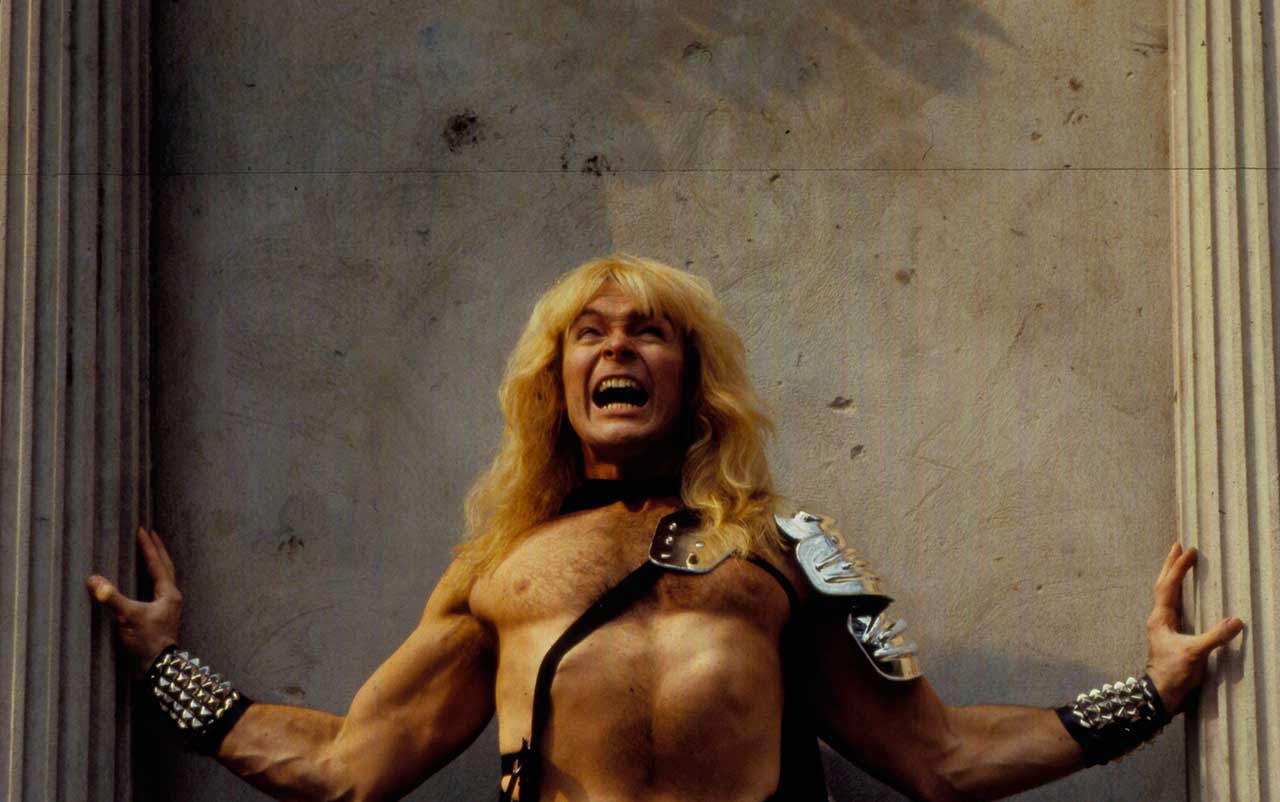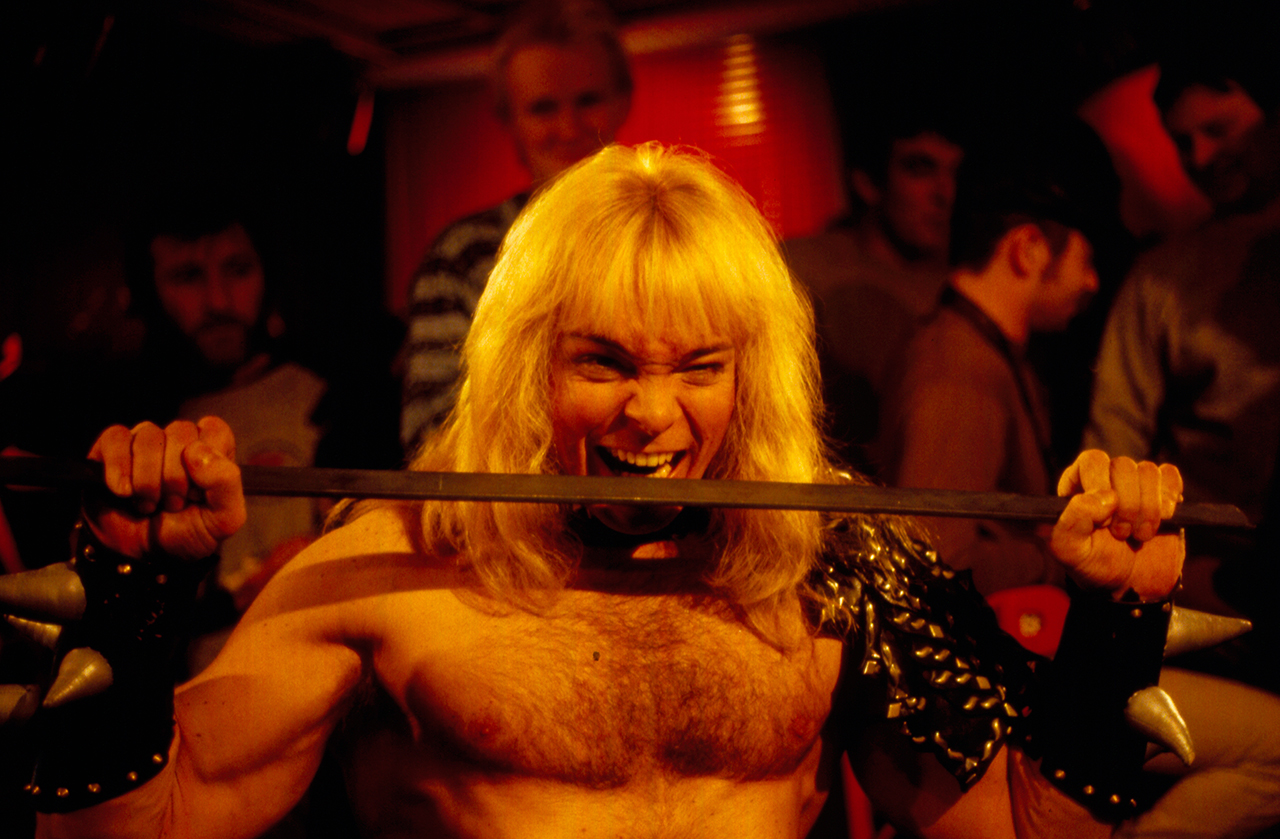Heavy metal has always been defined by bold, larger-than-life characters but as far as genuine superheroes go, there has only really ever been one; Thor. Emerging in the late seventies and reaching a commercial peak in the mid-eighties, most notably with the Only The Strong album, Thor was an act like no other, a heavy metal spectacle combining theatrics with genuine feats of strength, the legendary live shows including steel bar bending, brick smashing and, most famously, the eponymous frontman blowing up hot water bottles until they exploded.

Though he retired the band in 1986, Jon Mikl Thor would resurrect his alter-ego ten years later and has been active ever since, performing live and releasing a huge catalogue of studio albums. The definition of a cult act – despite some commercial success – the Thor name has nevertheless begun to return into public consciousness, not least because the muscular musician is now the star of a soon-to-be-released documentary film, one that captures the struggles and triumphs of this veteran entertainer in a manner not unlike that of Anvil’s now-famous biopic. We summoned the man himself from his otherworldly realm to get the full story on what is a truly unique career.
**The Thor act was quite unlike anything that came before in rock or heavy metal and indeed anything that has ever come since. What exactly was the background to the whole thing?
**“I started bodybuilding at seven years old and as time went on I started doing bigger bodybuilding competitions and at the same time I decided to get more heavily into bands, singing and playing bass. I was also really into ‘glitter rock’ or ‘show rock’, the theatrical rock of the late sixties and early seventies – I really got into Alice Cooper and David Bowie’s ‘Ziggy’ persona. Everyone was doing these big shows, the bigger the better, and I decided I would do that. If Bowie could be the Thin White Duke I would be the Rock Warrior. I was still bodybuilding and winning competitions like Mr Universe, but I decided to give that up to get more heavily into music.”
Seven seems a very young age to be into bodybuilding, presumably someone helped you get into that?
“My older brother was a bodybuilder and a sports hero. I looked up to him and tried to emulate him. Also you had Hercules and Superman on TV and I also read a lot of comics and I was fascinated by it all. I wanted to be like these characters and one way was to pump up. That’s why my bodybuilding was in my youth, I retired when I was nineteen. I was winning titles against guys in their twenties from the age of fourteen, so I was kind of ahead of my time. But it was very gruelling: I would follow these diets that were painful, bulking up and then only drinking water and eating vitamin pills for a month up until the competition. Then everyone started using steroids, and I didn’t want to do inject steroids and torture myself, so I decided to torture myself with show business instead, which I found out wasn’t so easy either.”
You certainly never made things easy on yourself with your live performances and the stunts you include as part of those shows.
“What do you do if you’ve got muscles? You have to do some performing. If Alice Cooper could hang himself and Gene Simmons breathe fire, I had to do things. The difference was my things were real and I would hurt myself many times. I would make my stunts bigger and better, like ripping license plates in two or having a bulldozer go over my chest – we had to go back to the drawing board on that one, way too dangerous. There was what I called ‘the secret of the steel’; that was taught to me by Doug Hepburn, who was the world’s strongest man at one point. There was another guy called Chuck Sipes who was Mr Universe and he’d do a show where he would blow up and explode a hot water bottle. I thought, ‘Wow, he must have superhuman lungs’, but he kind of showed me the secret to doing that.”
**Did you sustain any injuries doing these stunts?
**“I’ve had broken ribs, I’ve broken my teeth from bending steel bars, I’ve been knocked unconscious by exploding hot water bottles where they would get so big. In fact at clubs they would sometimes cover the dance floor like a Zeppelin and people would start running for cover! Another thing I would do was lift the heaviest person in the audience with my neck and one day a 400 pound woman got up on stage and I tried to lift her up and the whole platform broke and we rolled into the audience and almost crushed the people at the front. I’d also invite people to come up on stage and break bricks with a sledgehammer on my chest and of course sometimes they would miss. Anything I could do to entertain the audience at all cost. I would call myself the Evel Knievel of rock.”

What did people make of it all back then?
“At first people didn’t know what to make about it. At first we weren’t taken that seriously, but neither was Alice Cooper, so I understood that. When we first came out we were a novelty, we packed out places with people wanting to see us but a lot of labels were turning us down because it was too weird. As we got into the eighties we finally did get a record deal and a pretty good reception and it did pretty well, but it had lots of criticism as well because it was a ‘superhero’ singing. I think I was ahead of my time because we’re living in the world of the superheroes now, I sang that in my song Superhero [From first album, Keep The Dogs Away in 1977] I knew that superhero craze was going to get bigger and bigger so I just kept pursuing that.”
You appeared in quite a few movies as an actor over the years, but for the first time you are the subject of a full-length documentary. How was that experience?
“I’d like to say it was a fun, but it wasn’t so fun. It was another arduous experience. It took fifteen years to make this movie. I’ve been in numerous movies, Rock N Roll Nightmare, Zombie Nightmare, Recruits and so on, but this was a whole different thing. I was out of the business – I decided to retire in 1987 – so this movie was about me coming back after ten years of retirement. The producers saw me in Seattle and were knocked out by my show and said they wanted to do a documentary – I suppose they thought it would take two or three years and I suppose they thought I’d have a hit and it would be a happy ending. They just kept going on as the years went by – there were times I wanted to give up and times they wanted to give up. And of course if something is going wrong it’s like National Geographic when the lion is ripping the head of a giraffe, they just have to film it: I’d be in a place and my credit card wouldn’t go through and they’d be like, ‘No, we’re staying at the hotel but you have to stay on the street or in the lobby, we’re not helping you’. This film you can laugh, you can cry, you can hurl – it’s really a rollercoaster ride and it can take people emotionally to different places, I saw that when it was shown at Sundance.”
**You have a new album out called Metal Avenger and the film looks likely to introduce you to a whole demographic that was previously unaware of you. Do you think people get Thor in 2015?
**“Judging from the fans, they get it more now than they did in 1973. Superheroes are very popular, the bodybuilding/fitness thing has become quite mainstream and the kind of messages we’re getting on social media are very positive. People seem to really like our music and the whole concept.”
Thor’s new album Metal Avenger is out 30 October, via Cleopatra Records. Pre-order your copy here.
